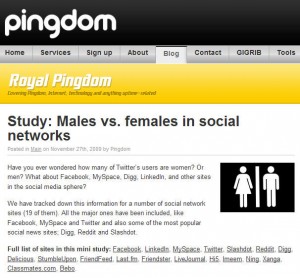Royal Pingdom recently figured up the ratio of men to women on nineteen social network sites, and the results are both not surprising and very surprising. Also very important for those companies wishing to reach potential job candidates through social media. Not in absolute terms (as pointed out at the end of this post) but as a reminder of the subtleties involved in social media strategy.
The “not surprising” part is that women significantly outnumber men in the social networking arena. Even though men were the earliest adopters of online activity and continue to lead in overall Internet use, women have taken more territory in the social networking landscape. The obvious explanation is that women are (in general) more social than men, and more interested in interpersonal communication—which is true in the aggregate, though not necessarily in smaller slices.
The “very surprising” parts are (a) the extent of the disparity in 2009, and (b) the enclaves that men have apparently chosen to occupy. Some details:
- Sixteen out of the nineteen sites included had a majority of women. MySpace is one of the most heavily female sites, with 65%.
- The two major sites had almost identical ratios: Twitter users are 59% female, Facebook 57% female.
- Men take over on the social news sites Digg, Reddit and Slashdot. In fact they really take over, with 82% male users on Slashdot, and 66% on Reddit.
- The most nearly balanced sites are Delicious, LinkedIn, StumbleUpon, and FriendFeed, all with just a slight female preponderance at 52%.
Several Pingdom commenters offer interpretations, pointing out that the male-favored sites are more about competition than sharing—that is, they focus on who’s got “the most” and “the best.” Also that the often snarky tone of Slashdot lacks feminine appeal (which definitely rings true) and that women may be less interested than men in content labeled “news for nerds.”
There are a number of caution factors to be considered in looking at the Pingdom summary, which is based on data from Google Ad Planner. First, it uses only U.S. data, which probably cannot be reliably extrapolated to other countries. Second, the data is not weighted, so “users” can range from people who merely have accounts (but never interact) all the way up to power posters. And third, many of these sites do not really figure into a recruiting strategy—or at least not obviously, not yet.
One Pingdom commenter points out that the best way to utilize these (and most) statistics about online activity is comparatively. Excellent advice! A lot of factors—such as fake profiles—may skew the numbers in absolute terms, but there is no doubt that the general indications are correct: lotsa men at Slashdot, lotsa women at MySpace, and so on.
Crafting a social networking strategy involves significant challenges—and obtaining the statistical information needed to evaluate various channels is just one of them. I found the Royal Pingdom info in a fantastic round-up from Jeremy Owyang, pulling together sources for a wide variety of statistical views. I’ll follow up on a few more and post further highlights soon.
Cynthia Giles has followed a serpentine career path from academia to publishing to marketing and design to information technology and corporate communications. There’s plenty of detail about this journey at www.cynthiagiles.com, but briefly--the common theme has been ideas, and how to present them effectively. Along the way, she became an accidental expert on data warehousing and business intelligence, and for the past ten years she has combined corporate contracting with an independent consulting practice that focuses on marketing strategy for smaller businesses and non-profits.
Having spent quite a bit of time looking for work, and anywhere from two weeks to two years inside a wide variety of American companies—she has given much thought to what works (and what doesn’t) when it comes to creating a great employment fit.




the social networking sites make our friends stay more closer, thats we really need.
I agree. I think men are more likely to try new things but then give up on them when they become “old hat.” Women are more likely to stick with something they enjoy and not get bored with it. Thanks for the post!
Kids In The Way